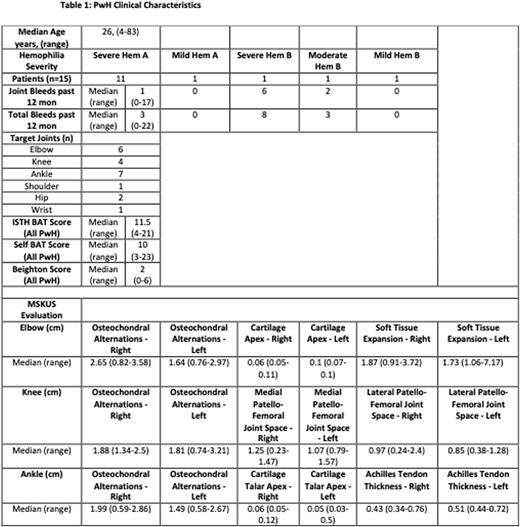Abstract
Introduction: Persons with hemophilia (PwH) A and B are known to have variable bleeding phenotypes and may have joint bleeding that is less clinically apparent. In recent years, musculoskeletal ultrasound (MSKUS) has become an established modality useful for evaluating joint status. Further, determination of individual bleeding phenotype can be challenging, but clinical tools including the International Society on Thrombosis and Haemostasis Bleeding Assessment Tool (ISTH-BAT), self-BAT, and the Beighton Hypermobility Score (BHS) have been developed.
Methods: We hypothesize that presence and degree of joint disease, evaluated with MSKUS and physical assessment scoring, will correlate with severity of bleeding phenotype as characterized through clinical history, BAT assessment, and presence of joint hypermobility in PwH A and B. This will be accomplished through assessing baseline joint status and disease progression over time with MSKUS, as well as through use of the ISTH-BAT, self-BAT, and assessment of hypermobility with the BHS. Up to 100 individual subjects with severe, moderate, or mild hemophilia A or B will be enrolled and assessed at baseline and annually during the study period at our institution. Correlation of joint status with BHS and BAT scores will be analyzed with the generalized estimating equation (GEE) and other statistical methods.
Results: Thus far, 15 male patients have been enrolled (Table 1). All moderate and severe hemophilia patients are on prophylactic therapies for bleed prevention, and 3 patients have history of inhibitors. Target joints were reported only in severe PwH. MSKUS measurements were completed using the JADE protocol1. Patient enrollment remains ongoing.
Discussion: Knowledge pertaining to joint status and bleeding phenotype is PwH A and B is limited. This pilot study will assess the presence and degree of joint disease, evaluated with MSKUS and physical assessment scoring, and its correlation with severity of bleeding phenotype as characterized through clinical history, BAT assessment, and presence of joint hypermobility in PwH hemophilia A and B. The results will be used to justify a larger, multicenter study to expand understanding of joint status and bleeding phenotype in PwH.
References 1. Volland, L.M., et al., Development and Reliability of the Joint Tissue Activity and Damage Examination for Quantitation of Structural Abnormalities by Musculoskeletal Ultrasound in Hemophilic Joints. J Ultrasound Med, 2019. 38(6): p. 1569-1581.
Disclosures
Roberts:Takeda, Genentech; Speakers Bureau: Novo Nordisk, Sanofi, Takeda: Research Funding; Novo Nordisk, Octapharma, Pfizer, Sanofi, Takeda, Genentech, Novartis: Consultancy. Tarantino:Pfizer: Research Funding; OctapharmaUSA: Honoraria, Research Funding, Speakers Bureau; Grifols: Speakers Bureau.
Author notes
Asterisk with author names denotes non-ASH members.


This feature is available to Subscribers Only
Sign In or Create an Account Close Modal